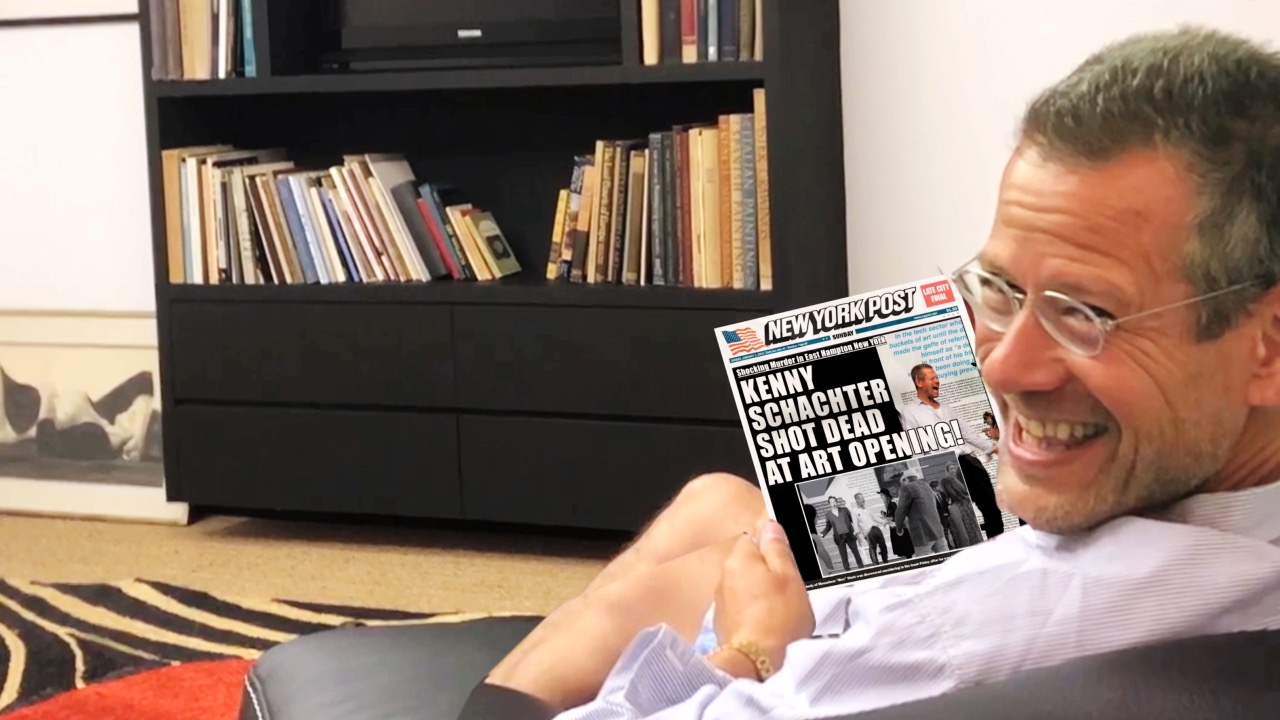Death be not proud (it’s bound to happen sooner or later). Video still courtesy of Kenny Schachter.
In the waning days of summer, just when you might expect the art world to be napping beachside in the Mediterranean, guess what? There’s no rest for the weary, because the avid buccaneers of the art market are going at it as per usual—voraciously and omnivorously. Deals don’t rest in the enclaves of the (very, very) rich and famous, and you can almost feel the frenzied energy as prices for obvious artworks by obvious artists continue their seemingly endless upward trajectory, soaring past Jack’s beanstalk and beyond Brancusi’s Endless Column. (That Romanian sculptor’s market is on the rise, too; read on.)
One artist who attracts money like a Cali-style black hole, Mark Grotjahn, is in the midst of pulling a rabbit out of his hat that could forever ensure his primary market’s place in the record books. A foreign regime wanted to commission a large-scale Grotjahn work and approached a prominent gallery, which sent the only emissary on staff who the prickly artist might be hoped to deal with. Surprisingly, Grotjahn agreed—and then dropped the bombshell of his asking price. The gallery tried pleading for him to be reasonable, offering to accept a significantly reduced fee, but the artist wouldn’t budge—that was the price, take it or leave it. Rather than balk, the royals appear ready to bite at press time—for a price a good deal higher than the $45 million Yusaku Maezawa reportedly paid for his Grotjahn triptych a few years ago.
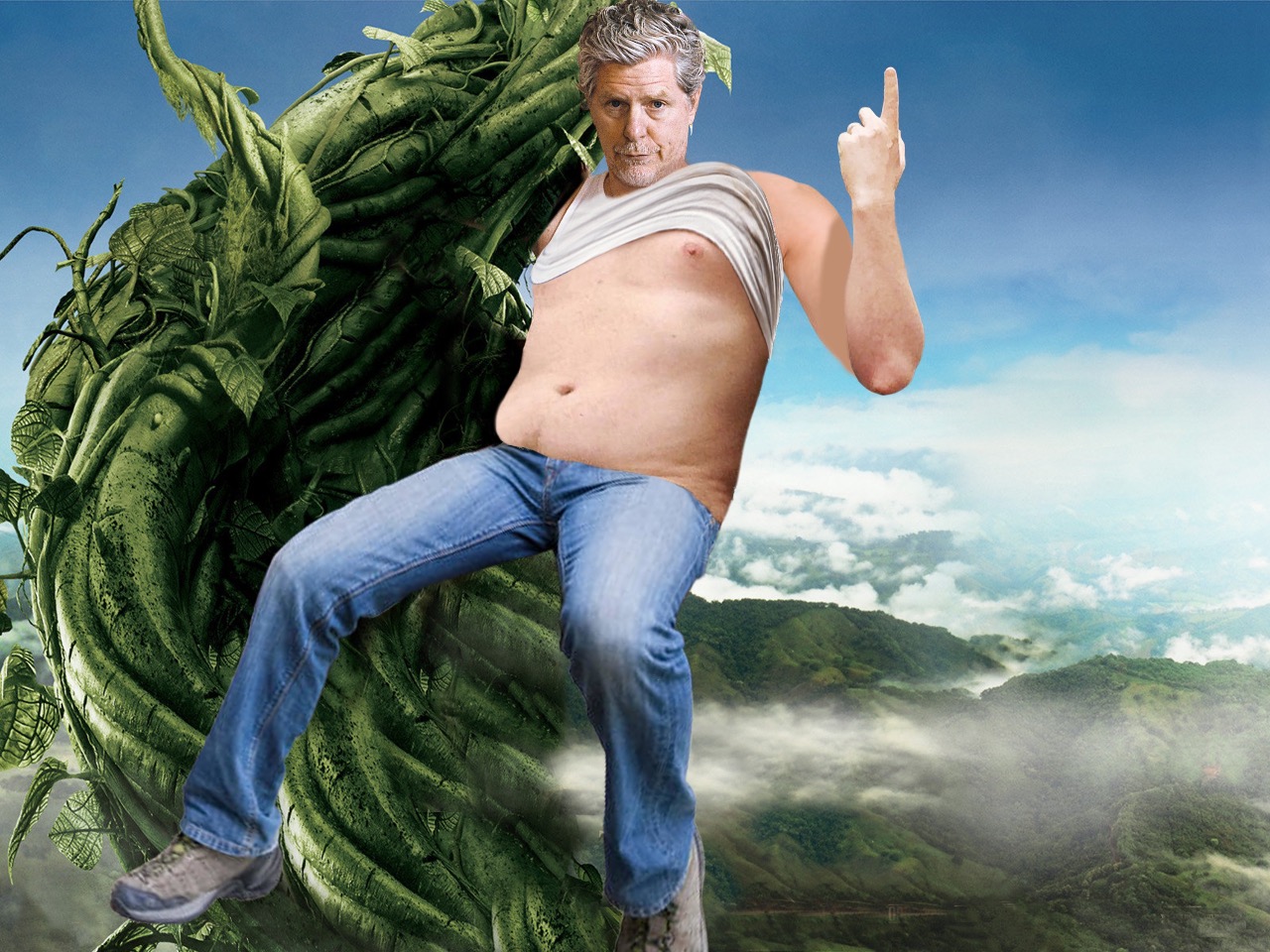
Mark Grotjahn and the beanstalk. Photo illustration by Kenny Schachter.
It’s never all smooth sailing, to be sure—I know, because I’ve spent the bulk of my August chasing stalled payments and impossible-to-pin-down viewings, encountering excuses like “I can’t reach my client—he’s on a yacht.” (Last I checked, boats—especially the gas-guzzling monsters that collectors (and a certain mega dealer) favor—have state-of-the-art means of communication.) Another secondary work I was pursuing was described as having had one owner and two outstanding loans against it.
Incredibly, the next spate of art fairs is already upon us now: in September alone, booths will be popping up to sling gallery wares in Chicago, Vienna, Berlin, Copenhagen, Istanbul, and even Long Island at the Bridge—art and cars, what could be better. Lucky for you, I’ll be skipping this round of the circuit—I’m too glued to my phone watching the unfolding tax saga that might very well find Mary Boone cooling her Pradas in prison, trading the white cube for a concrete one (and still killing deals). “Free Mary” will be the rallying cry to come.
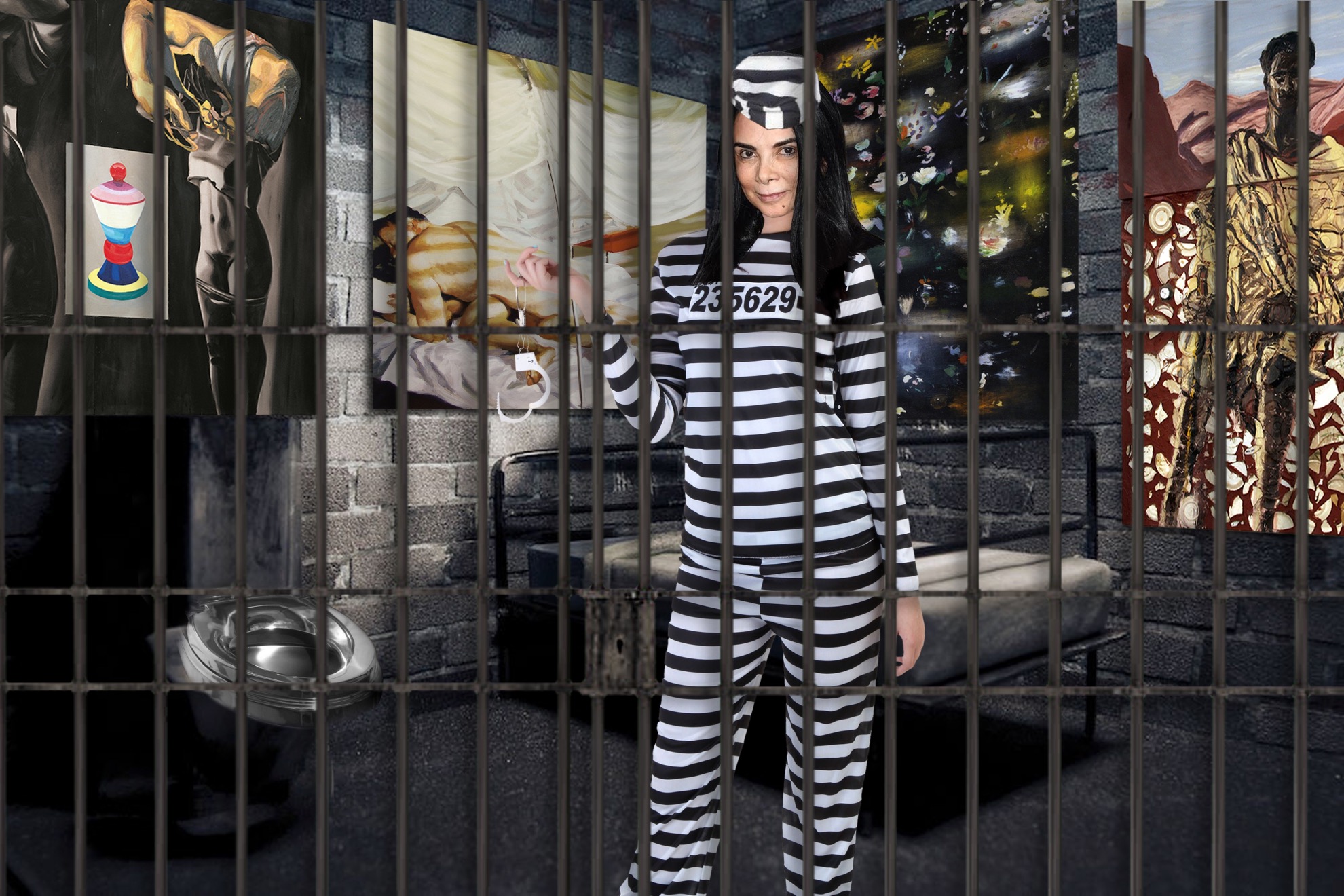
Mary Boone’s next gallery outpost? Photo illustration by Kenny Schachter.
Meanwhile, fall highlights include Brancusi and Duchamp at Paul Kasmin Gallery, and I can’t wait to see what Brancusi has been up to this summer—he’s had some of his most prolific years since his 1957 death. As with Aston Martin (and many other vehicle manufacturers of late), galleries reissuing hits from their back catalogue is the new norm.
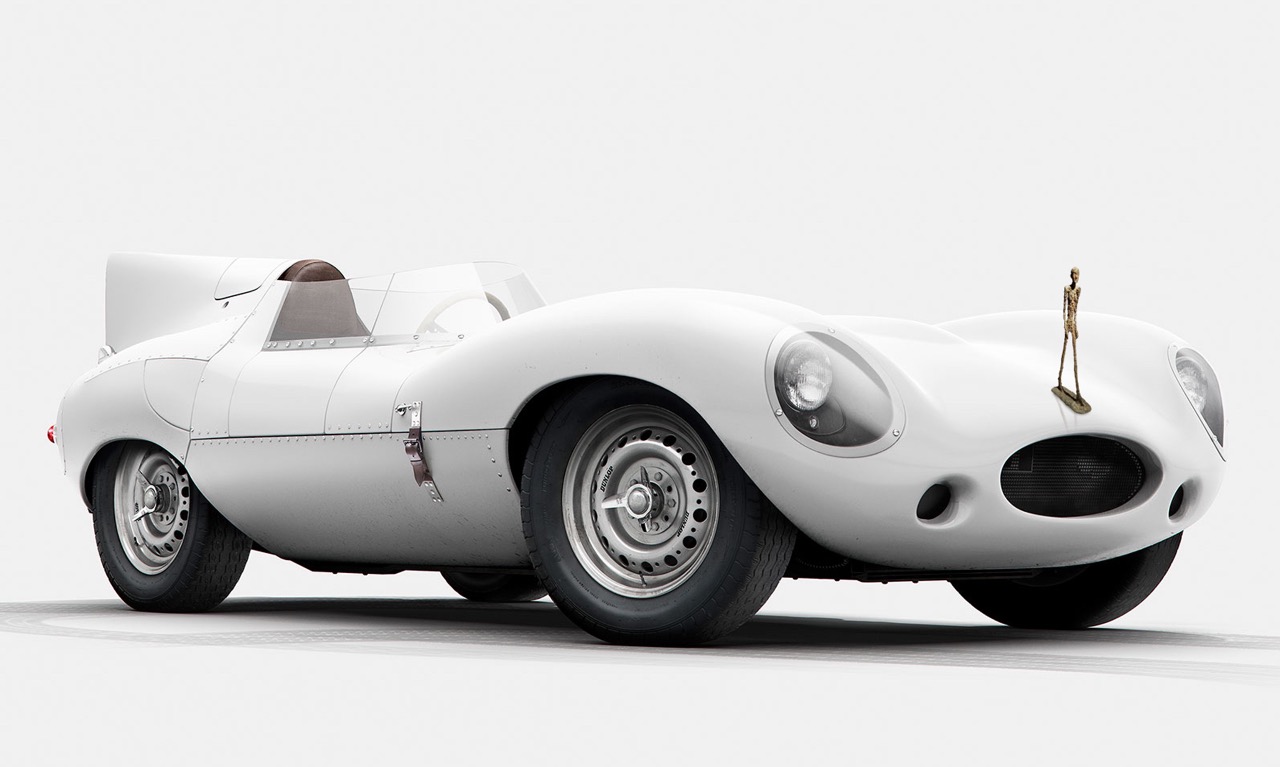
Old Jags and Giacomettis—keep ’em coming. Dead artists are busier than ever. Image courtesy of Kenny Schachter.
The Hamptons
You might be incredulous to hear it, but the Hamptons are (kind of) off the grid, meaning there’s only one road in and out, phone signals are next-to-nonexistent, there are more fecund deer than householders, and as many families of wild turkeys roam about as the human variety. There’s no shortage of Long Island ducks constantly flying overhead (and an equal amount of ginormous private planes, many doubtlessly from Manhattan). The local Japanese place even serves up duck sushi—thankfully, I don’t eat meat. But can’t the likes of Spielberg, Seinfeld, J.Lo, Jay-Z, and Larry G. chip in for a cell tower or two?
Besides the famously high hedges in a constant state of topiary rectitude, it’s the light that continues to attract artists—it really is other worldly. There’s also something laid-back and touchingly extraordinary regarding the mentality of many residents, be they locals or seasonals. For example, my family pulled up to one of many roadside farm stands to buy some insanely addictive fresh corn and pies, and when I was caught cash-short (surprise, surprise) another shopper asked, without hesitation, if I wanted a loan! Can you imagine? I replied, how about $2.5 million for a Wool?
In what other tony enclave are keys left in cars and front doors uniformly left unlocked, as opposed to in every European city and resort, which are experiencing meteorically rising violent crime rates? Maybe I shouldn’t have advertised that fact. I know multiple families in St. Tropez who have had gasses pumped into their windows or ventilation systems before being stripped of their possessions as they lay passed out on the floor. Yes, they never snoozed so soundly, but it cost them a few watches and laptops.
Newtown Lane in East Hampton is a veritable one-road art district with five interesting galleries: Eric Firestone, Valentine, the Drawing Room (not the most imaginative of names, granted—there were dozens at last count), Halsey McKay, Harper’s Books, and Rental Gallery—as many, in other words, as you’ll find in any London art neighborhood. Valentine’s pitch for a secondary-market Kaws with an asking price of a whopping $1.6 million was a real winner, describing it as “a museum-quality shaped-canvas that the owner doesn’t even want to sell.” As my kids would say, as if. In any event, everyone was at it up and down Newtown Lane, hustling with same tenacity as at any given Basel, only clad in shorts and sneakers.
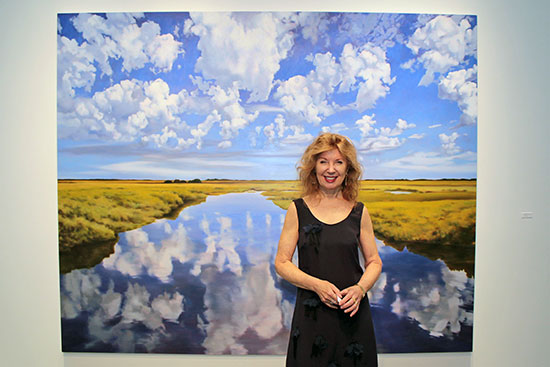
The artist April Gornik. Photo by Tom Kochie.
Sotheby’s was punching above its weight when it hired Christy MacLear this July, nabbing her after a stint at the Rauschenberg Foundation—but the multitasking auction house, struggling to be a player representing artists and estates, could not keep MacLear’s talents, and now she’s about to co-launch a recently announced artist-incubating foundation with Eric Fischl and the brilliant and unsung painter April Gornik (who happens to be Fischl’s wife) in a glorious old church in Sag Harbor that they’re restoring together. And I’m not just saying that because MacLear bought a book and t-shirt from my Rental Gallery retrospective. Yep, you heard that right… your humble columnist-cum-artist just had his first career survey.
The Retrospective
I can’t even recall how Joel Mesler and I met a few years ago, but he is a younger version of me, namely a jack of all (art) trades: making, curating, dealing, and gallery-ing. (That’s what we aim for, anyway.) He’s hilarious, supportive, talented, and fun and just off the back of a sold-out show of his own paintings at Simon Lee Gallery in London, with another unannounced show on deck at a major LA gallery. Working together was an natural, effortless fit, other than when he sent out promotional material that spelled my name incorrectly. Twice. Also, his gallery was closed when some key collectors showed up on a Wednesday, which was disappointing. That’s why we attract each other, I guess—our preternaturally similar degrees of professionalism. In a few short weeks of gallery representation, I’ve transitioned into a pushy artist. That didn’t take long.
Before I entered the gallery to install, I went next door and bought a Wayne Thiebaud book—signed in blue pen with a little red heart drawn beside it, as he often signs his paintings—from the inimitable Harper’s Books, the namesake bookstore and gallery in Long Island and New York City owned by Harper Levine. It’s not cheap to be decamped next to Harper’s shop, but I could spend all day and night there. A book was also published on the occasion of my show—not by Harper (yet)—mimicking a remembrance of my life published to mark my untimely (others might disagree) demise. The idea came to me because I’ve always had a yen to write my obituary, in case no one else would condescend to take up the task. My shrink said I’m desensitized to death (my mother passed when I was 13), but I’d rather just discount it in this lifetime and simply acclimate myself to the notion that it’s getting invariably closer, to the point you begin to smell it….
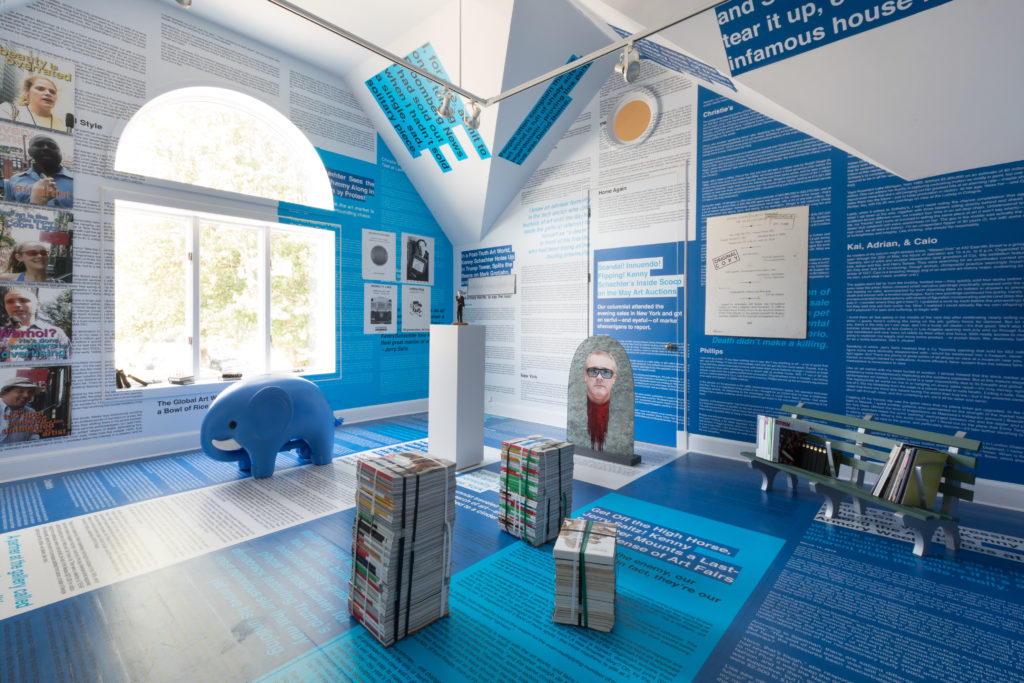
Virtual reality without the reality: artnet News comes to life in Kenny’s Rental Gallery installation. Photo courtesy of Kenny Schachter.
Along with a one-person show of my own came a whole new set of concomitant fears and anxieties—in spades. Just what a knee-jerk neurotic needs: I was paralyzed with back spasms before I set foot in Kennedy Airport ahead of the festivities. When I first entered the space I encountered noted artist and local resident Rashid Johnson giving Joel—who paints in the basement like a Jewish Jean-Michel—an impromptu studio critique. My anxieties were mounting by the minute. Not to mention, openings make me physically ill, let alone when they revolve around my own art (this is my fifth solo outing in 20-some years).
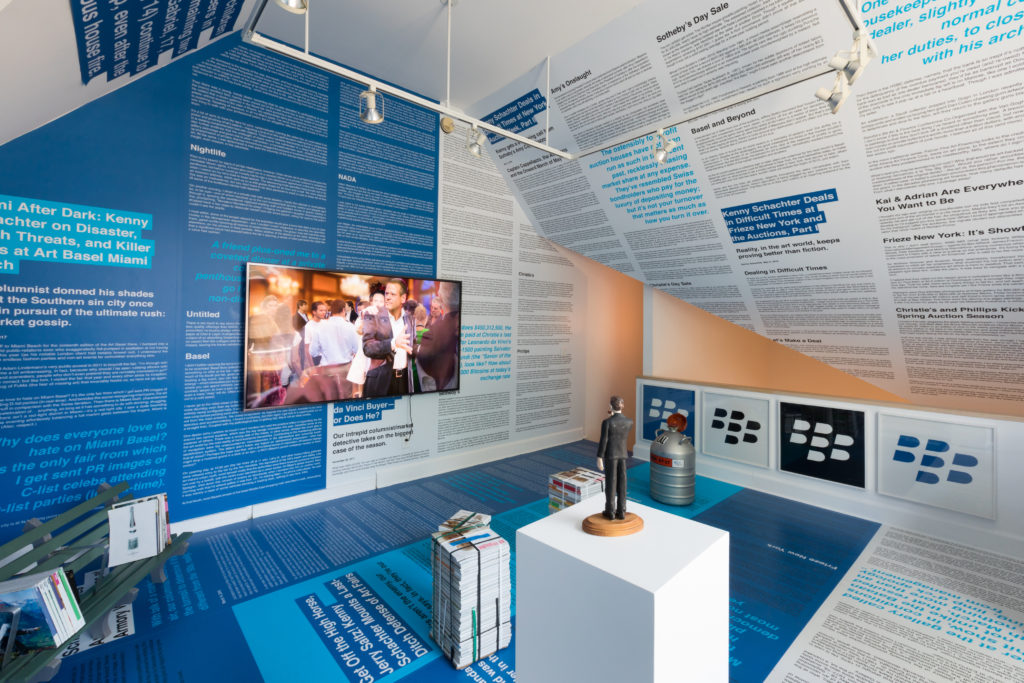
Thankfully, big screens go for small money, so now I can screen all my videos from the past 25 years. Not sure if that’s good or bad news for visitors. Photo courtesy of Kenny Schachter.
While I occupy the attic and a backroom office, the main gallery features LA artist Mindy Shapero—an über-assistant to Mike Kelley in a previous life—who exhibits kaleidoscopically colorful felt assemblages and sculptures that put one in mind of Joseph Beuys in the desert tripping on ayahuasca. Together, we’ll be up on the walls through October. My biggest fear, also addressed in therapy, was that this whole enterprise was nothing more than a grand folly by way of a midlife crisis (my second). Throwing caution to the wind, I soldiered on. It was worth it. For one thing, I’ve never seen any of the videos I’ve made since the mid-1990s on anything bigger than a computer screen—and, though I couldn’t manage to Jordan-Wolfson-ize it scale-wise, I got up to 86 inches on a flat screen (the prices of which have plummeted from status symbol to cheap commodity).
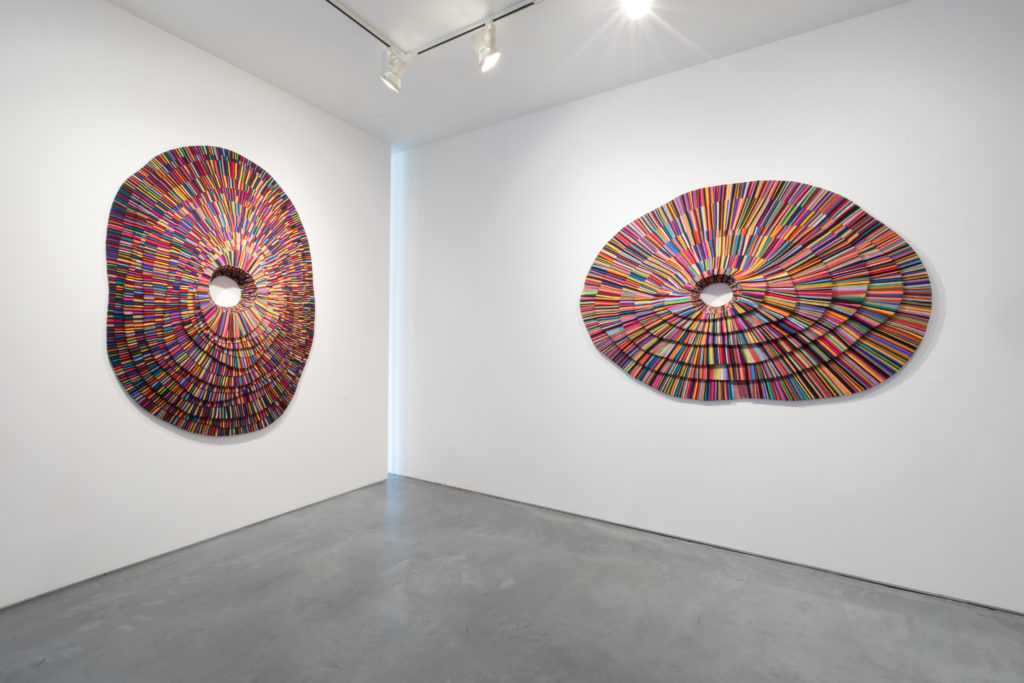
Mindy Shapero installation: Joseph Beuys after a stint in the desert experimenting with ayahuasca. Photo courtesy of Kenny Schachter.
A graphic from a spa in China once caught my eye depicting an elephant extending his trunk beneath his torso to self-fellate above text that read “Forbidden Amuse Yourself.” I wasn’t certain if it was meant to proscribe or prescribe such activity and I’m not going to say whether I could or couldn’t do just that growing up an alienated, isolated (lithe) kid in Long Island. Anyway, back to China, I went armed with an image of the poster and had it 3D-rendered into a series of painted plastic piggybanks—it just seemed the right way to go, a collision between Vito’s Seedbed and Jeff’s Balloon Dog (dare I say). One satisfied customer proclaimed: “The piece is absolutely hilarious—perfect. I must own this self-centered, self-masturbatory elephant piggy bank!” Not dissimilar from the act of me writing about my show.
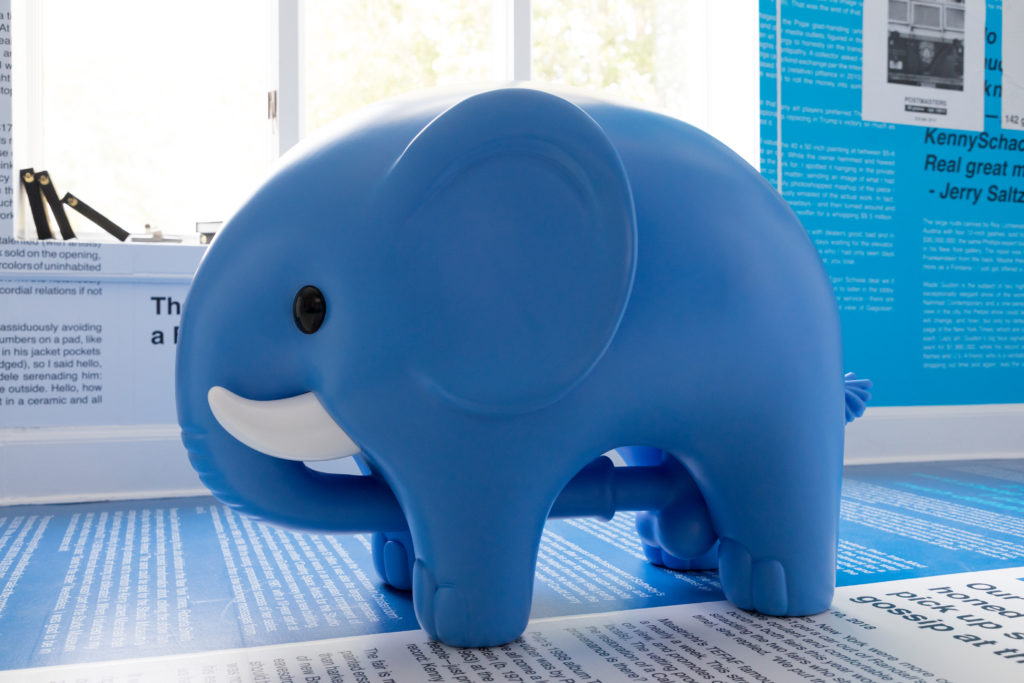
Forbidden Amuse Yourself, by Kenny Schachter. Photo courtesy of Kenny Schachter.
With vinyl print-outs wrapping the floors, walls, and ceiling in my previous artnet News columns, the attic space has been transformed into an immersive assault on viewers—virtual reality, without the reality. Aside from multiple colors and iterations of the self-sucking piggybanks, there are T-shirts galore emblazoned with my artnet illustrations—merch not high and low, but low and lower. (Just what the world needs.) During the opening, I asked a gallery assistant for a price list and Mary Heilmann, who I showed in 2002 and adore more than I can say, reprimanded me in no uncertain terms: “You don’t put prices on the list, dummy!” On subsequent visits I overheard the following exchange: “Who is Schachter?” “I don’t know him but I know he has no market. How would you describe his work, ‘post-post-appropriation’?” After the last remark, I fled the gallery like a shot cannonball.
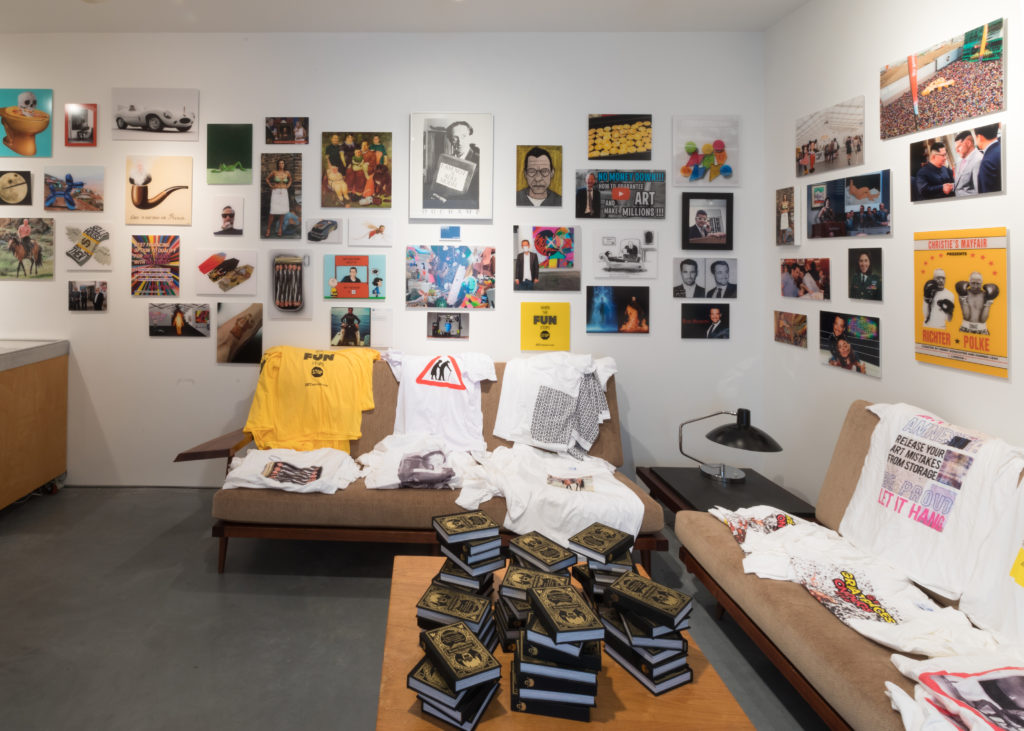
There is something for everyone, literally—the merch ranged from low to lower on the scales of cultural production, and came in every size. Photo courtesy of Kenny Schachter.
Oddly enough, I found myself (again, well into midlife) an old emerging artist, showing at a small-to-mid-level gallery—when they are said to be under siege—and selling. Actually, selling a lot! And to top-flight gallerists and collectors, many of whom I have long known and admired. (Never fear, there’s still plenty left and lots of time to grab your checkbooks and pay a visit to Joel and Harper.) I was so flabbergasted I shed a tear. Okay: I uncontrollably wept, for days. Though don’t get me wrong, the prices of my work is still on average equal to or less than that of my artist children, which I guess I should say makes me proud of them (but makes me think I should ask for a cut).
I can get used to this artist-with-a-retrospective-thing, fast. It’s not like I’m going to have a show every month from hereon in, but there is an upcoming group effort, “Family Guy,” opening October 2nd at Simon Lee Gallery (we are an incestuous lot in the art world) together with my wife and kids (if we are speaking again by then) and another one-person outing at Neils Kantor in Los Angeles during February’s inaugural Felix and Frieze art fairs in that city. Stranger things have happened, I suppose—I just haven’t heard of any.

